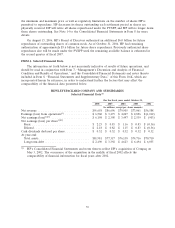HP 2006 Annual Report Download - page 42
Download and view the complete annual report
Please find page 42 of the 2006 HP annual report below. You can navigate through the pages in the report by either clicking on the pages listed below, or by using the keyword search tool below to find specific information within the annual report.HEWLETT-PACKARD COMPANY AND SUBSIDIARIES
Management’s Discussion and Analysis of
Financial Condition and Results of Operations (Continued)
of restructuring in the Results of Operations section and Note 8 to the Consolidated Financial
Statements in Item 8, which are incorporated herein by reference.
Stock-Based Compensation Expense
Effective November 1, 2005, we adopted the fair value recognition provisions of Statement of
Financial Accounting Standards (‘‘SFAS’’) No. 123 (revised 2004), ‘‘Shared-Based Payment’’
(‘‘SFAS 123R’’), using the modified prospective transition method, and therefore have not restated
prior periods’ results. Under this method, we recognize stock-based compensation expense for all share-
based payment awards granted after November 1, 2005 and granted prior to but not yet vested as of
November 1, 2005, in accordance with SFAS 123R. Under the fair value recognition provisions of
SFAS 123R, we recognize stock-based compensation expense net of an estimated forfeiture rate and
recognize compensation cost for only those shares expected to vest on a straight-line basis over the
requisite service period of the award. Prior to SFAS 123R adoption, we accounted for share-based
payment awards under Accounting Principles Board Opinion No. 25, ‘‘Accounting for Stock Issued to
Employees’’ (‘‘APB 25’’) and, accordingly, generally recognized compensation expense only when we
granted options with a discounted exercise price.
Determining the appropriate fair value model and calculating the fair value of share-based
payment awards require the input of subjective assumptions, including the expected life of the share-
based payment awards and stock price volatility. Management determined that implied volatility
calculated based on actively traded options on HP common stock is a better indicator of expected
volatility and future stock price trends than historical volatility. Therefore, expected volatility in fiscal
years 2006 and 2005 was based on a market-based implied volatility. The assumptions used in
calculating the fair value of share-based payment awards represent management’s best estimates, but
these estimates involve inherent uncertainties and the application of management judgment. As a
result, if factors change and we use different assumptions, our stock-based compensation expense could
be materially different in the future. In addition, we are required to estimate the expected forfeiture
rate and recognize expense only for those shares expected to vest. If our actual forfeiture rate is
materially different from our estimate, the stock-based compensation expense could be significantly
different from what we have recorded in the current period. See Note 2 to the Consolidated Financial
Statements in Item 8 for a further discussion on stock-based compensation.
Taxes on Earnings
We calculate our current and deferred tax provisions based on estimates and assumptions that
could differ from the actual results reflected in our income tax returns filed during the subsequent year.
We record adjustments based on filed returns when we have identified and finalized them, which is
generally in the third and fourth quarters of the subsequent year for U.S. federal and state provisions,
respectively.
We recognize deferred tax assets and liabilities for the expected tax consequences of temporary
differences between the tax bases of assets and liabilities and their reported amounts using enacted tax
rates in effect for the year in which we expect the differences to reverse. We record a valuation
allowance to reduce the deferred tax assets to the amount that we are more likely than not to realize.
We have considered future market growth, forecasted earnings, future taxable income, the mix of
earnings in the jurisdictions in which we operate and prudent and feasible tax planning strategies in
determining the need for a valuation allowance. In the event we were to determine that we would not
be able to realize all or part of our net deferred tax assets in the future, we would increase the
38
























